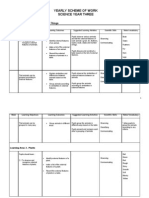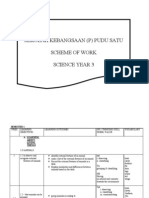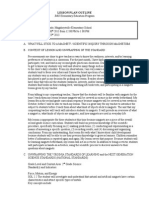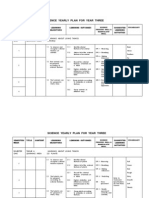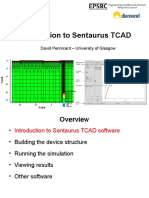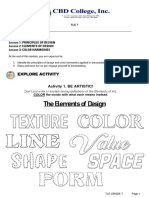Learning About Living Things
Uploaded by
Sayid AdnanLearning About Living Things
Uploaded by
Sayid AdnanLearning about Living Things
Le arning Obje ctives 1. Anim als Pupils Pu pils observe various animals and list the external f eatures of each animal e.g. tail, f ur, f eathers, scales, beak, claw s and number of legs. x identif y external f eatures of an anima l. x ma ke a list of the external f eatures of an anima l. Teachers may need to help pup ils na me some of the external f eatures of animals. Discuss w ith pupils the f eatures that they w ant to record in the table. beak claw s f eathers f ur horn legs scales tail w ings Suggested Le arning Activities Le arning Outcomes Notes Vocabulary
Pupils s hould le arn 1.1 to observe and recognise external f eatures of animals.
1.2 that anima ls can be grouped according to external f eatures. 1.3 that anima ls can be grouped in many w ays.
x record the external f eatures Pu pils d iscuss and of anima ls in a tab le. construct a table based on the list of external f eatures. x explain similarit ies and dif f erences betw een animals based on th e table . Pu pils group the animals in dif f erent w ays based x group anima ls according on the table. to similarit ies in external f eatures. Pu pils present and compare each others grouping of anima ls. x group anima ls in dif f erent w ays.
Allow pupils to group the anima ls according to any criteria that they choose based on their table.
11
Le arning Obje ctives 2. Plants
Suggested Le arning Activities
Le arning Outcomes
Notes
Vocabulary
Pupils s hould le arn 2.1 to observe and recognise external f eatures of plants. Pu pils observe various plants and list the external f eatures of each plant e.g. w oody or sof t stems, f low ering or non-f low ering, rough or smooth leaf surf ace, colour of leaf and shape of leaf .
Pupils x identif y external f eatures of a plant. x ma ke a list of the external f eatures of a plant. x record the external f eatures of plants in a table. Teachers may need to help pup ils na me some of the external f eatures of plants. Discuss w ith pupils the f eatures that they w ant to record in the table. dull green red rough shiny smooth sof t w oody yellow
2.2 that plants can be grouped according to external f eatures. 2.3 that plants can be grouped in many w ays.
Pu pils d iscuss and construct a table based on x to explain similarit ies and the list of external f eatures. dif f erences betw een plants based on the table. Pu pils group the plants in dif f erent w ays based x group plants according to on the table. similarit ies in external f eatures. Pu pils present and compare each others grouping of plants.
Allow pupils to group the plants according to any criteria that they choose based on their table.
x group plants in d if f erent w ays.
12
Learning about the World Around Us
Le arning Obje ctives 1. Magne ts Pupils Pu pils explore a variety of mag nets e.g. bar magnets, horseshoe magnets, cylindrical magnets, circular magnets. Pup ils observe w hat happens w hen they put tw o mag nets near each other. Pu pils d iscuss the proper w ay to handle magn ets during activities. Pu pils d iscuss the need to handle mag nets properly. Pu pils explore a variety of objects made f rom dif f erent materia ls and are asked to predict w hich objects w ill be attracted by a ma gnet. x demonstrate that magnets can attract or repel each other. x state that magnets can attract or repel each other. Teachers may introduce the w ords north pole and south pole of a magnet. attract iron mag net plastic repel silver w ooden steel Suggested Le arning Activities Le arning Outcomes Notes Vocabulary
Pupils s hould le arn 1.1 that magnets can attract or repel each other.
1.2 to handle mag nets properly.
x demonstrate the proper w ay Re mind pup ils not to drop or knock a to handle magnets. mag nets as this w ill cause a magnet t o lose its magnetis m. x demonstrate that magnets attract some materia ls but not others. x record their f indings in a table. x state the objects that are attracted by magnets. Teachers may use the same type of object made of dif f erent materia ls f or this activity e.g. w ooden spoon, steel spoon, plastic spoon and silver spoon.
1.3 that magnets attract some mater ials.
13
Le arning Obje ctives
Suggested Le arning Activities Pu pils group the materia ls according to w hether or not they are attracted by a mag net.
Le arning Outcomes
Notes Teachers explain that objects that are attracted by magnets are made of iron. Accept all pla ns. Allow pupils to modif y their plans if they f ace dif f iculties w hen carrying out their tests.
Vocabulary
1.4 that magnets have dif f erent strengths.
Pu pils design a f air test x design a f air test to to compare the strengths compare the strengths of of dif f erent magnets. dif f erent magnets by Pupils have to decide how deciding w hat to keep the to measure the strength of same, w hat to change and a mag net e.g. how many w hat to measure. paper clips the magnet can attract and hold or how x carry out the test and record close to a paper clip a the observations. mag net has to be to at tract it. x f orm a conclusion based on the observations. Pu pils carry out their tests and record the f indings in x explain how they arrive at a table. the conclusion. Pu pils f orm a conclusion based on the observations e.g. magnet A is the strongest because it can hold the most nu mber of paper clips.
14
Le arning Obje ctives 1.5 the dif f erent uses of magnets.
Suggested Le arning Le arning Outcomes Activities Pu pils bring things that x state w here magnets are ma ke use of magn ets, e.g. used. mag netic pencil box, toys, and f ridge magn x explain w hat a magnet ets. is used f or. Pu pils d iscuss about how mag nets are used in the things they bring. Pu pils ma ke a toy, a ga me or a device using ma gnets e.g. f ishing w ith a mag net, mag netic dancer and mag netic f astener. x ma ke a toy, a ga me or a device using ma gnets.
Notes Teachers can show examples of things that use ma gnets to help the pu pils th ink of other things that use magnets.
Vocabulary
15
Le arning Obje ctives 2. Ele ctricity
Suggested Le arning Activities
Le arning Outcomes
Notes
Vocabulary
Pupils s hould le arn 2.1 how to make a bulb in a circuit brighter or dimmer. Pu pils are g iven batteries, battery holders, connecting w ires, bulbs and bulb holders. Pu pils bu ild a circuit to ma ke a bu lb light up . Pu pils d iscuss w ays to ma ke the b ulb in the circuit brighter and dimmer. Pu pils test the ir suggestions. Pu pils draw the circuit that they made.
Pupils x suggest w ays to make a bulb in a circuit brighter. x design a circuit that ma kes the bulb light up brighter. Accept all pup ils plans. Allow pupils to mod if y their plans if they f ace diff iculties w hen carrying out the tests. brighter dimmer
Re mind pup ils to use only batteries x show perseverance in ma king a circuit that ma kes and not electricity f rom the the bulb brighter. ma ins supply to carry out experiments x explain the circuit. as it is dangerous. x draw the circuit. x design a circuit to make a bulb dimmer. Teachers guide pupils to conclude that the bulb is brighter w hen more electricity f low s through it.
16
Le arning Obje ctives 2.2 that some mater ials conduct electricity.
Suggested Le arning Activities Pu pils list materia ls that they think w ill conduct electricity. Pu pils p lan a circuit to investigate w hich materials conduct electricity. Pu pils bu ild th e circuit to test w hich materials conduct electricity. Pu pils record their f indings in a tab le. Pu pils d iscuss and f orm conclusions. Pu pils share their f indings.
Le arning Outcomes x predict w hich materials can conduct electricity. x build a circuit to test w hich mater ials conduct electricity. x record the f indings in a table. x f orm conclusions based on the f indings.
Notes Teachers guide pupils to understand that w hen a material that conducts electricity complet es a circuit, the bulb w ill light up . To test w hether a mater ial conducts electricity, pupils may use objects make of dif f erent materia ls such as w ooden rulers, meta l rulers, plastic spoons etc.
Vocabulary meta l plastic w ood
17
Le arning Obje ctives 2.3 that a sw itch is used to complete or break a circuit.
Suggested Le arning Activities Pu pils ma ke an inco mplete circuit. Pu pils d iscuss how to comple te the circuit to allow the bulb to be turned on or off . Pu pils bu ild th e circuit and test it. Pu pils exa min e dif f erent types of simple sw itches and try to explain how each type of sw itch w orks. Pu pils d iscuss diff erent w ays that a bulb can be turned on or of f . Pu pils create a simple sw itch using everyday objects e.g. spring and paper clips.
Le arning Outcomes
Notes
Vocabulary
x ma ke a circuit w hich allow s Teachers guide a bulb to be turned on or of f . pupils to understand that a bulb w ill light x explain how the bulb can be up w hen a circuit is comple te and w ill not turned on or of f . light up w hen a circuit x state that a sw itch is used to is incomp lete. comple te or break a circuit. x create a simple sw itch.
18
Le arning Obje ctives
Suggested Le arning Activities
Le arning Outcomes
Notes
Vocabulary
3.
Springs Pupils Pu pils bend , tw ist, stretch or squeeze springs of dif f erent lengths and dia meters. x state that a spring returns to its origina l size and shape af ter being bent, tw isted, stretched or squeezed. x state that it is easier to bend, tw ist, stretch and squeeze some springs than others. Pu pils d iscuss a) w hat type of springs they w ant to test e.g. springs of diff erent lengths or springs of dif f erent dia meters. b) how to test w hich spring stretches the most e.g. by hanging an ob ject of the same w eight at the end of the spring and measuring how much it stretches. c) how to record their f indings. x design a f air test to f ind out w hich spring stretches the most by decidin g w hat to keep the sa me, w hat to change and w hat to measure. Accept all pla ns. Allow pupils to modif y their plans if they f ace dif f iculties w hen carrying out the tests. bend shape size spring squeeze stretch tw ist
Pupils s hould le arn 3.1 that a spring returns to its original size and shape af ter being bent, tw isted, stretched or squeezed.
3.2 that springs stretch diff erently.
Pu pils can use nonx carry out the test and record standard tools such as strips of paper to the observations. measure how much the spring stretches. x f orm a conclusion based The strips of paper on the observations. can be used as a record of how much x explain how they arrive at the spring stretches. the conclusion.
19
Le arning Obje ctives
Suggested Le arning Activities Pu pils carry out their tests and record their f indings. Pu pils f orm a conclusion based on the f indings e.g. the longest spring stretches the most.
Le arning Outcomes
Notes
Vocabulary
3.3 the uses of springs.
Pu pils bring things that use springs e.g. mechanica l pencils and hand ba llpens. Pu pils d iscuss how springs are used in these things.
x state w here springs are used. x explain w hat the spring is used f or.
20
Le arning Obje ctives 4. Abs orption
Suggested Le arning Activities
Le arning Outcomes
Notes
Vocabulary
Pupils s hould le arn 4.1 that some mater ials can absorb w ater. Pu pils carry out an activity to f ind out w hich materia ls absorb w ater.
Pupils x identif y materials that absorb w ater. Pu pils can use everyday objects mad e of diff erent mater ials f or this activity, e.g. coins, cloth, pebbles, paper and tissue paper. Accept all pla ns. Allow pupils to modif y their plans if they f ace dif f iculties w hen carrying out their tests. absorb cloth coins pebbles tissue paper
Pu pils d iscuss 4.2 that some x design a f air test to test mater ials a) w hat materials they the ability of diff erent w ant to test e.g. diff erent can absorb materials in absorbing w more mater ials or dif f ater by deciding w hat to w ater than others. erent types of tissue keep the same, w hat to paper. change and w hat to b) how to f ind out w hich measure. mater ials absorb the most w ater. x carry out the test and record c) how to record their the observations. f indings. x f orm a conclusion based Pu pils carry out the test on the observations. and record their results in a table. x explain how they arrive at the conclusion.
21
Le arning Obje ctives
Suggested Le arning Activities Pu pils f orm conclusions based on their f indings e.g. tissue paper A is the most absorbent because it absorbed the most amount of w ater. Pu pils d iscuss w hy the ability of materia ls to absorb w ater is usef ul f or certain jobs e.g. a mop needs to be absorbent to mop up w ater.
Le arning Outcomes
Notes
Vocabulary
4.3 the uses of the ability of materia ls to absorb w ater.
x explain the uses of the ability of materia ls to absorb w ater.
22
Le arning Obje ctives 5. Soil
Suggested Le arning Activities
Le arning Outcomes
Notes
Vocabulary
Pupils s hould le arn 5.1 w hat soil is made up of . Pu pils mix some soil w ith w ater in a tall container. Pu pils shake t he mixture and allow it to settle. Pu pils observe the layers that are f ormed. Pu pils draw , label and describe w hat they observe. Pu pils repeat th e process using soil sa mples f rom dif f erent places. Pu pils d iscuss a) w hat type of soils they w ant to test. b) how to compare how w ell w ater moves through dif f erent types of soil. c) how to record their f indings.
Pupils Teachers guide pupils to understand that soil contains living th ings and x state the dif f erences betw een soil samp les f rom non- living th ings. dif f erent places. x describe w hat soil is made up of . clay garden soil sand soil
5.2
the f low of w ater through dif f erent types of soil.
x design a f air test to compare how w ell w ater moves through sand, clay and garden soil by decid ing w hat to keep the sa me, w hat to change and w hat to measure.
Accept all pla ns. Allow pupils to modif y their plans if they f ace dif f iculties w hen carrying out the tests.
Pu pils should get the same a mou nt of x carry out the test and record sand, clay and garden soil. the observations.
23
Le arning Obje ctives
Suggested Le arning Activities Pu pils carry out the test and record their f indings. Pu pils f orm a conclusion based on their f indings.
Le arning Outcomes x f orm a conclusion based on the observations. x explain how they arrive at the conclusion.
x design a f air test to
Notes
Vocabulary
5.3 that certain soils are more suitab le f or plant grow th.
Pu pils d iscuss a) how to compare the grow th of a green bean in clay, garden soil an d sand. b) how to record their f indings. Pu pils carry out the test and record their f indings. Pu pils f orm a conclusion based on their f indings.
compare the grow th of green beans in clay, garden soil an d sand by deciding w hat to keep the sa me, w hat to change and w hat to measure.
Accept all pup ils plans. Allow pupils to mod if y their plans if they f ace diff iculties w hen carrying out their tests.
x carry out the test and record the observations. x f orm a conclusion based on the observations. x explain how they arrive at the conclusion.
24
Le arning Obje ctives 6. M ixing Substances
Suggested Le arning Activities
Le arning Outcomes
Notes
Vocabulary
Pupils s hould le arn 6.1 that dif f erent substances have dif f erent properties. Pu pils are g iven dif f erent substances such as w heat f lour, tapioca f lour, sugar, salt, baking pow der and milk pow der. Pu pils observe and record the appearance, sme ll, f eel and colour of the substances. Pu pils test the substances w ith w ater and vinegar and record their observations. 6.2 that some Pu pils are show n labels f substances are unsaf e and should or some unsaf e be handled w ith substances. care. Pu pils d iscuss the danger of touching, smelling or tasting these unsaf e substances.
Pupils x state the properties of dif f erent substances in terms of appearance, smell, f eel and colour. x describe the results of mixing dif f erent substances w ith w ater. x describe the results of mixing dif f erent substances w ith vinegar. x state that dif f erent substances have diff erent properties. x identif y labels f or unsaf e substances. x explain the meaning of the labels. x list unsaf e substances. Pu pils should not touch, taste or mix substances unless the teacher tells the m it is saf e to do so. Pu pils should test only a sma ll a mount of each substance. Pu pils may f ind that their f indings might not be enough to f orm a conclusion. baking pow der milk pow der salt tapioca f lour vinegar w ater w heat f lour
Teachers need only to discuss labels on household substances such as detergent, bleaching agent and med icine.
25
Le arning Obje ctives
Suggested Le arning Le arning Outcomes Activities Pu pils w atch a video on x state the need to look at how unsaf e substances labels or ask an adu lt cause harm and how these bef ore touching or unsaf e substances should tasting any substance. be handled. Pu pils list unsaf e substances and tell w hat harm they can cause. x list the har m caused by unsaf e substances. x plan how to separate a mixture of substances. x present their processes of separating the mixture in w ords or diagrams.
Notes
Vocabulary
6.3 that a mixture of substances can be separated.
Pu pils are g iven a mixture of substances e.g. f ine sand, small stones, small polystyrene balls, salt and paper clips. Pu pils are challenged to separate the mixture in the shortest possible time. Pu pils d iscuss in groups on how mixtures can be separated. Pu pils carry out their plans to separate the mixture. Pu pils evaluat e methods of separating the mixture presented by others.
Teachers discuss possible methods of separating mixtures e.g. using f ilter paper, mag nets, sieve etc.
x give reasons w hy the meth ods are able to separate the mixtures. x compare dif f erent methods of separating the mixtures x explain w hy one meth od of separating mixtures may be better than another.
26
You might also like
- Week 1 4 - 8 January: Learning Objectives Suggested Learning Activities Learning Outcomes Notes VocabularyNo ratings yetWeek 1 4 - 8 January: Learning Objectives Suggested Learning Activities Learning Outcomes Notes Vocabulary13 pages
- Yearly Plan For Science Year 3: Theme: Learning About Living ThingsNo ratings yetYearly Plan For Science Year 3: Theme: Learning About Living Things13 pages
- Yearly Scheme of Work Science Year Three: First TermNo ratings yetYearly Scheme of Work Science Year Three: First Term14 pages
- Sekolah Kebangsaan (P) Pudu Satu Scheme of Work Science Year 3No ratings yetSekolah Kebangsaan (P) Pudu Satu Scheme of Work Science Year 318 pages
- Science Yearly Plan Year 3: THEME: A. Learning About Living ThingsNo ratings yetScience Yearly Plan Year 3: THEME: A. Learning About Living Things14 pages
- Yearly Plan Science Year 3 Week / Theme Learning Area Learning Objectives Learning Outcome Suggested Learning Activities Vocabular yNo ratings yetYearly Plan Science Year 3 Week / Theme Learning Area Learning Objectives Learning Outcome Suggested Learning Activities Vocabular y13 pages
- Yearly Plan Science Year 3 Week / Theme Learning Area Learning Objectives Learning Outcome Suggested Learning Activities VocabularyNo ratings yetYearly Plan Science Year 3 Week / Theme Learning Area Learning Objectives Learning Outcome Suggested Learning Activities Vocabulary13 pages
- POP Cycle Requirements: Crystal Salgado 1 Ms. Emily Day ScienceNo ratings yetPOP Cycle Requirements: Crystal Salgado 1 Ms. Emily Day Science44 pages
- Learning Standard:: Round Table Gallery Walk Think, Pair, Share Hot SeatNo ratings yetLearning Standard:: Round Table Gallery Walk Think, Pair, Share Hot Seat5 pages
- Learning Objectives 1. Animals Pupils Should LearnNo ratings yetLearning Objectives 1. Animals Pupils Should Learn6 pages
- Bay Area Scientists in Schools Presentation PlanNo ratings yetBay Area Scientists in Schools Presentation Plan13 pages
- Natalie Scholbergs Eled 432 Children and Science Lesson Plan - MagnetsNo ratings yetNatalie Scholbergs Eled 432 Children and Science Lesson Plan - Magnets15 pages
- Science Year 3 Yearly Plan: A. Learning About Living ThingsNo ratings yetScience Year 3 Yearly Plan: A. Learning About Living Things16 pages
- Science Companion Electrical Circuits Field Trip83% (6)Science Companion Electrical Circuits Field Trip41 pages
- Lesson Plan For Content Methods Semester: Establishing The Lesson FrameworkNo ratings yetLesson Plan For Content Methods Semester: Establishing The Lesson Framework5 pages
- Science Lesson 2 Magnets and Other MaterialsNo ratings yetScience Lesson 2 Magnets and Other Materials4 pages
- Toyworld: Games and Toys: Science Unit - Stage OneNo ratings yetToyworld: Games and Toys: Science Unit - Stage One3 pages
- STEM Integrated Concepts: Physical Science: 2nd GradeNo ratings yetSTEM Integrated Concepts: Physical Science: 2nd Grade5 pages
- Sciencepalooza: A Collection of Science Poetry for Primary and Intermediate StudentsFrom EverandSciencepalooza: A Collection of Science Poetry for Primary and Intermediate StudentsNo ratings yet
- Elementary Science Experiments: Analyzing Data to Make PredictionsFrom EverandElementary Science Experiments: Analyzing Data to Make PredictionsNo ratings yet
- Altus Group Cost Escalation Report - HR Multi-Family - Dec 2020 - TorontoNo ratings yetAltus Group Cost Escalation Report - HR Multi-Family - Dec 2020 - Toronto18 pages
- Judge Floro's 15 Pages, April 1, 2011 Supplemental Omnibus Motions - Part 2No ratings yetJudge Floro's 15 Pages, April 1, 2011 Supplemental Omnibus Motions - Part 216 pages
- Cooking Breakfast Cereals: Flaked Products From Maize Corn Flake Process Flow ChartNo ratings yetCooking Breakfast Cereals: Flaked Products From Maize Corn Flake Process Flow Chart10 pages
- Psychology Theories of Learning From S.K MangalNo ratings yetPsychology Theories of Learning From S.K Mangal21 pages
- Situs Inversus Totalis in A 72-Year-Old Man WestAfrJRadiolNo ratings yetSitus Inversus Totalis in A 72-Year-Old Man WestAfrJRadiol4 pages
- Advanced Technology International 2012 Catalog100% (1)Advanced Technology International 2012 Catalog94 pages
- Ejaculation: Jump To Navigation Jump To SearchNo ratings yetEjaculation: Jump To Navigation Jump To Search14 pages
- (Signed) 2021 Team Ventura Contract-R5-08172019No ratings yet(Signed) 2021 Team Ventura Contract-R5-0817201911 pages
- Development of Extension Education in IndiaNo ratings yetDevelopment of Extension Education in India55 pages
- Model of The Home Food Environment Pertaining To Childhood ObsityNo ratings yetModel of The Home Food Environment Pertaining To Childhood Obsity18 pages






